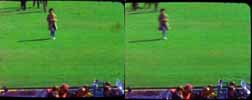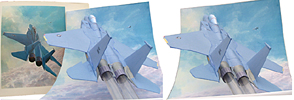Most of these images were created as stereo pairs using the parallel viewing method, and only one uses the cross-eyed method. For a brief discussion of stereo imaging and the methods to view them, click here and scroll down to "Orthostereography". I prefer stereo pairs because it allows one to see color accurately and easily versus the tinting effect using red/blue glasses.
I have not found an easy way to teach how to view a stereo pair. Let me try to explain how to use the parallel method (my personal preference). The goal is to see three images and then focus on the middle image. To help me merge the two original images, I hold up my hand vertically and tilt it on the vertical axis so that when I look thru the left eye, my hand blocks the right image and for the right eye, it blocks the left image. This should help make the "middle" image begin to appear. Then, it is a matter of allowing your eyes to bring it into to focus so that the middle image predominates over the images on either side of it. Viewing distance comes into play as well. You need to find a distance that allows you to comfortably focus on the image pair. For example, the balloon image works best for me at a distance of about 3-1/2 feet from the screen. Perhaps the simplest way to get started is to find a 3D viewer. Here is a link to some viewers.
Stereo Anaglyph Viewing (Requires red / blue or red / cyan glasses)
Anaglyph of the Yosemite Valley. Half Dome is just right of center.
Model is a DC-3 in service with a Canadian airline
Stereo-Pair Free Viewing (parallel viewing or cross-eyed viewing)
The view from a hot air balloon of SW Fort Collins.
The stereo effect is achieved by snapping two pictures a few seconds apart while drifting.
The same technique as above as taken from an airliner flying over Minnesota.
The view from on top of Horsetooth Rock, Fort Collins, CO looking south.
This demonstrates that a stereoview can be made from a pair of movie frames.
These are Zapruder frames 310 and 312-Kennedy's last conscious moment.
A paper model of the prototype F-15A based on a painting by Keith Ferris, August 2007
This uses the cross-eyed viewing method. Another view of the model with a reproduction of the originl painting on the left.
Plaster cast made of Lincoln after his death
- displayed in Smithsonian Museum of American History
Mid-1800s locomotive
- displayed in Smithsonian Museum of American History
A gem
- displayed in the Smithsonian Museum of Natural History













